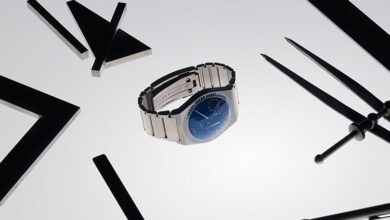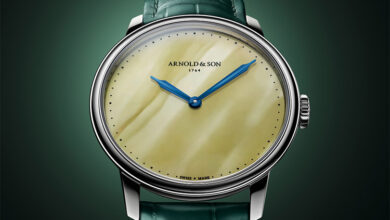Louis Moinet’s ode to the elements
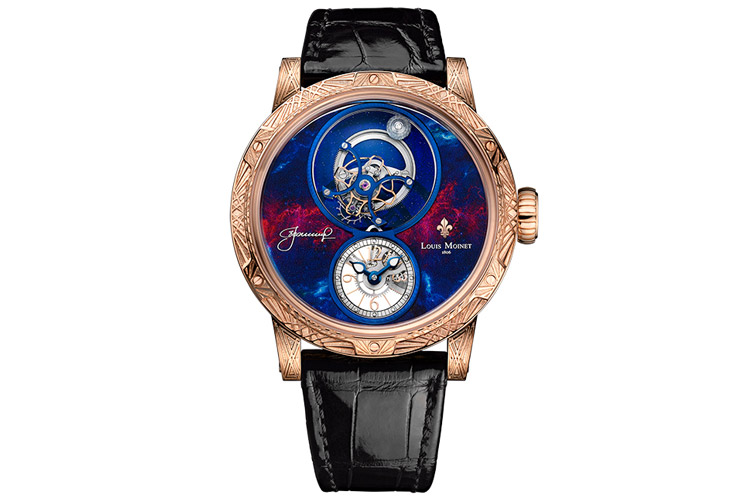
This year, haute horlogerie creations from Swiss watchmaker Louis Moinet celebrate not only to the elements but man’s mastery over them. While the SpaceWalker pays tribute to the first man to walk in space, Skylink celebrates mankind’s first interstellar handshake, the Tempograph acknowledges the importance of time in seconds, and the Sundance pays homage to the glory of the sun and the Milky Way
SpaceWalker
SpaceWalker is a satellite tourbillon that forges a bond between Alexey Leonov and Louis Moinet who have been drawn together by their twin destinies – the dreams of both having led to them making their mark in history. SpaceWalker is dedicated to Leonov, and to all those playing their part in the progress of humankind.
The tale is that of an individual and, like the greatest stories, one of humility: that of Alexey Leonov, who on March 18, 1965, became the first man to walk in space. While he may not be the best-known of space-farers – overshadowed as he often is by those involved in the moon race – he was a vital pioneer, in whose footsteps they followed.
Then, too, there is the humility of Louis Moinet: the man now officially recognised as being the inventor of the chronograph, the author of one of the most foundational works in watchmaking – his 1848 Traité d’Horlogerie – who nonetheless remained virtually unknown for the best part of two centuries.
The destinies of Moinet the astronomer and Leonov the cosmonaut have been brought together in “SpaceWalker” – an exceptional contemporary creation dedicated to Alexey Leonov, a man who was not only the first to walk freely in space but also the initiator of one of the most symbolic gestures in all history – an interstellar handshake with his NASA counterpart in 1975, at the height of the Cold War, which went on to experience an unexpected thaw.
Today, Louis Moinet’s SpaceWalker commemorates this unparalleled hero. The timepiece features an outsize tourbillon at 12 o’clock, representing Leonov’s spaceship on his Voskhod 2 mission. A diamond revolves around the tourbillon, representing Alexey Leonov himself, floating in space outside his spacecraft. The decision to use a diamond was quite deliberate: “Almaz-2” was Leonov’s code name during the mission (his partner was known as “Almaz-1”) – and “almaz” is the Russian word for diamond. The picture would not be complete without an evocation of the vastness of the cosmos – represented by an aventurine background that becomes transparent when exposed to light.
A new creation by Louis Moinet, the SpaceWalker dial makes use of an exclusive, secret graphic composition, depicting an artistic view of the starry heavens in which Leonov drifted at will for 12 minutes and 9 seconds on March 18, 1965. Also visible is a nebula – a collection of interstellar dust and gases – its exceptional colours providing a unique backdrop for the SpaceWalker. This celestial artwork pays discreet homage to another passion the two pioneers Alexey Leonov and Louis Moinet share; both loved to paint. The innovative method used to produce it is a closely-guarded secret.
At 6 o’clock, Louis Moinet’s characteristic “dewdrop” hands indicate the hours and minutes, extending across a sapphire dial offering glimpses of the mechanics of the fine watchmaking movement. The back offers an unobstructed view, with a sapphire crystal revealing SpaceWalker’s highly distinctive bridges.
In celebration of those 12 minutes spent in the freedom of space, Louis Moinet has produced two limited editions, each comprising 12 engraved watches in rose or white gold, alongside two other limited editions comprising 18 non-engraved pieces, also in white or rose gold.
Skylink
Louis Moinet celebrates the Apollo-Soyuz mission that changed the face of the world with its Skylink. Following on from SpaceWalker, Louis Moinet has unveiled a second creation commemorating the great Russian cosmonaut’s 1975 Apollo-Soyuz adventure – the first joint space mission between the Soviet Union and the United States of America. Soyuz 19 was launched from Baikonur Cosmodrome, and Apollo from Cape Canaveral, Florida, before the two met up for mankind’s first-ever rendezvous in space.
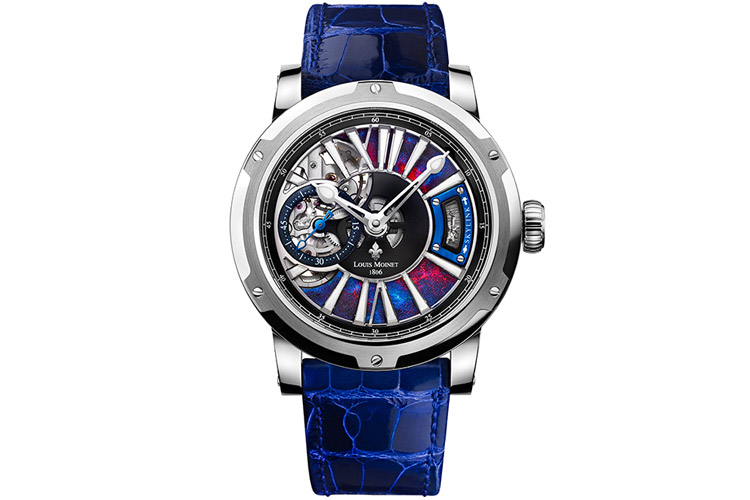
A turning-point after 50 years of Cold War, the event stands out as an oddity for historians and space buffs alike. Apollo and Soyuz were space travel codenames in the USA and the former USSR respectively, and in 1975, the world was in the throes of the Cold War. The two superpowers were opposed in every way, not least in a frenetic space race.
How could the two self-declared enemies establish an alliance at the heart of one of their arenas of conflict? Enter Alexey Leonov, a champion of the hopes of mankind. The cosmonaut was to change the face of the world at 7.20pm on July 17, 1975. At that precise moment, both spaceships were docked in space; only the hatch of Soyuz 19 separated it from Apollo. In opening the hatchway, Alexey Leonov also opened up a new world of peace and cooperation; his first interstellar handshake with Commander Thomas Stafford was an unforgettable moment. Today, Louis Moinet proudly celebrates this achievement in the conquest of space – and, more importantly, in human relations – with a timepiece called Skylink, recalling the link that was quietly forged between two men, each representing their nations, in the depths of space.
The Skylink’s dial depicts this sidereal expanse. A graphic process that is exclusive to Louis Moinet allows the creation of colours reminiscent of a nebula – a collection of interstellar dust and gases of infinite hues. Two of Louis Moinet’s hallmark “dewdrop” hands glide over this composition. The raised three-dimensional hour markers reaching out across this dial give the piece a real sense of depth – an architectural aspect that further enhances their very special finish. Their sides feature a diamond-cut, satin-finish section that reflects light deep into the dial, setting the timepiece sparkling with life. The colour contrast is enhanced by each lacquer-coated hour marker. The seconds are marked off on their counter at 9 o’clock; subtle changes in its hue, from dark blue through to purple, can be seen as light strikes its fine metallised coating.
At 3 o’clock sits a special, exclusive Skylink feature: a micro capsule containing, for all eternity, a fragment of Kapton foil – the polyamide fabric that protected Apollo on its return to Earth on July 24, 1975 – together with fibres from the Russian Sokol-K spacesuit. Used for the first time on Soyuz 12 in 1973, the same model is still in use today. Louis Moinet’s capsule establishes a physical link connecting the adventure of 43 years ago, space itself, the astronomy from which watchmaking originally derived, and each of the owners of the watches in this unique collection.
This very limited edition of 19 white gold, 19 rose gold, and 75 steel watches comes on a dark blue or black strap. The numbers are a tribute to 1975 – the year of the Apollo-Soyuz mission. The dial of each piece bears an authentic reproduction of Alexey Leonov’s signature.
Tempograph 20-Secondes
The second-generation Tempograph 20-Secondes offered by Louis Moinet features a full black finish and an imposing new case. The success of the Tempograph 20-Secondes is no doubt due to the fact that it is the embodiment of all Louis Moinet’s values. For one thing, it consists of a series of very limited editions and unique pieces that many collectors have patiently sought to acquire. Then too, it is a timepiece that boasts technology and aesthetics in equal measure – a balance that is clearly visible on the dial. And lastly, the piece features an exclusive animation, epitomising the creative aspirations with which Ateliers Louis Moinet has always been imbued. The 20-second retrograde hand is powered by workings that are visible on the left side of the dial.
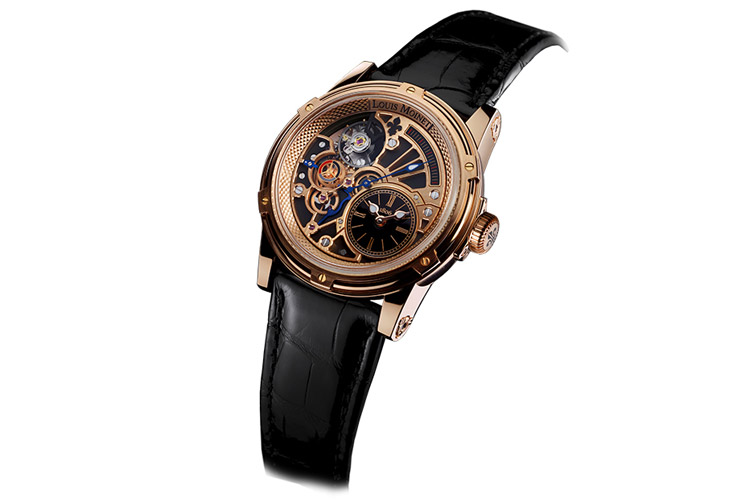
The new-generation Tempograph 20-Secondes includes two major firsts. It features a completely black surround. This extends from the bridges that structure the movement to the flange, itself engraved with a concentric Clou de Paris pattern. The time dial located at 4 o’clock also features the concentric Clou de Paris pattern, a Louis Moinet hallmark. Fully lacquered in black, it sets off the Louis Moinet’s signature “dewdrop” hands perfectly.
The timepiece is housed in a new case, borrowed from Louis Moinet’s Memoris collection, the first chronograph watch in history. Packed with 52 components, the case is now down to 44 millimetres from its former 46 mm, and is fully reworked to accommodate the Tempograph 20-Secondes’ retrograde movement. This is also the first time this prestigious case has been made in steel.
These two changes mark a turning-point in the Tempograph saga, so much so that Louis Moinet sees this as constituting the second generation of the timepiece. More modern, more powerful, and even more characterful, the piece is now entering a new, more contemporary era.
Sundance
Louis Moinet’s latest offering for women is a solar ode. Each of these animated timepieces will feature a unique dial, just as every woman is herself unique. Some Louis Moinet creations are guided by technology, others by aesthetics; others again, more usually, by a subtle combination of both. Sundance stands out as a timepiece whose guiding inspiration has been the discovery of new creative horizons. The main feature of this new collection is its dial, once again revealing the ability of Ateliers Louis Moinet to design entire microcosms of unequalled wealth and diversity – and encapsulate them beneath a sapphire crystal.
Even though this collection comprises 60 watches, each dial is entirely unique. To achieve this deliberate aim, a wholly unprecedented manufacturing method has been devised, which is kept secret. Every single dial’s brilliant, intense, many-hued base is unique, because no two colour doses are alike. The one master craftsman authorised to produce the mix and installation arranges his composition by hand, producing a different effect each time. In addition, a powder composed of microscopic particles – literally the stuff of dreams – twinkles in the light: hundreds of stars illuminating an infinite, opalescent galaxy.
The Sundance dials are thus redolent with multi-hued variations, evocative of the infinite expanse of the Milky Way. Each of these exceptionally coloured dials feature two “dewdrop” hands gliding over it, together with an openwork sun at the centre of this miniature galaxy. Queen of the solar system, this star dances elegantly, marking off the seconds. Like its real-world counterpart, it too gives off a warmth and energy all its own – that of resplendent beauty.
The Sundance case is very much the equal of the dial, being both creative and original. It is based on the open-style architecture of the “Neo” case, devised by Louis Moinet to house all of its recent creations. Sundance uses its structure while innovating at the same time. Its main compartment encloses the watch’s automatic mechanism with a decidedly avant-garde material: translucent, blue-coloured neoralithe. The case is delicately inserted between two slim, graceful, openwork gold bridges that span the assembly and secure the alligator strap at either end. Louis Moinet has used the space between these bridges to engrave a series of original motifs on the case itself. These are a faithful reproduction of historical architectural drawings engraved in stone in Bourges (France), as observed by Professor Louis Moinet when he attended the School of Fine Arts, at the turn of the nineteenth century. Ateliers Louis Moinet have reproduced them on the Sundance case, protecting them with the same translucent blue composite used on the four case lugs, each resembling an aerial view of the Earth.
Sundance will be available with jewel settings on the dial (twelve diamonds, one on each hour marker) and bezel, as well as with three concentric rows of diamonds opening towards the outside of the bezel.




